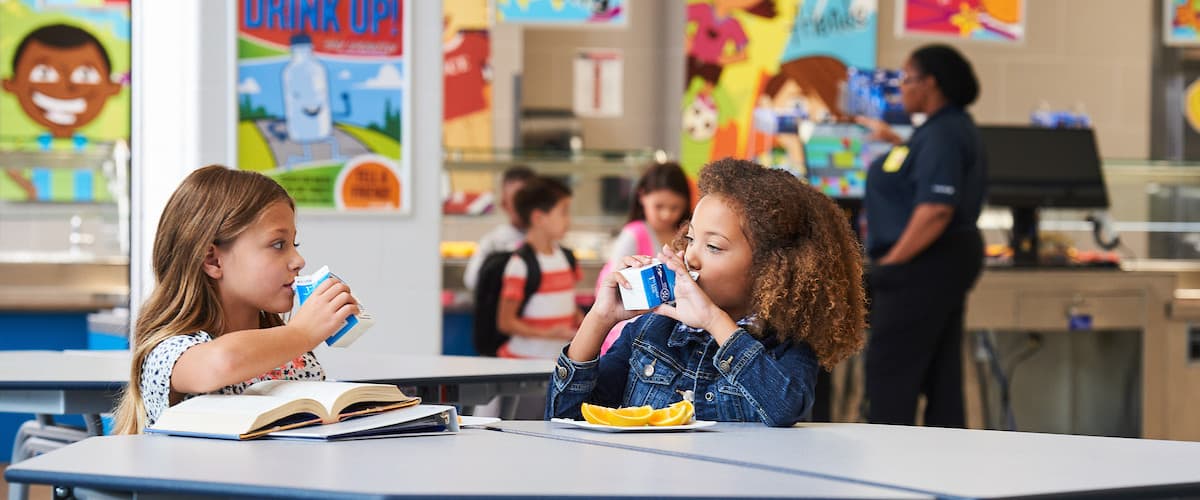For some parents, school lunches might evoke images of a drab piece of pizza, mystery meat, or bland carrot slices. That may well have been the case back in the 1980s and 90s when federal funding for school lunches was slashed, and schools had to rely on less expensive, more processed food in their meal programs. But not today.
Now, there’s legislation in place that requires schools to provide students with a healthy, balanced diet high in nutrients, one that taps into all food groups and includes more vegetables, fruit, and whole grains in every meal.
School lunches have been revamped, and, in many cases the transformation includes fun foods prepared in interesting ways.

Alysia Spooner-Gomez, RDN
What’s more, research shows kids that participate in their school’s meal program end up eating more fruits, vegetables, whole grains, and milk during meal times, while the overall quality of their diet is better than students who don’t participate.
A study from the American Medical Association suggests the 2010 federal law requiring schools to serve healthier meals led to lower body mass index rates.
Some school lunches today also include produce from local farms, helping teach kids critical lessons about where their food comes from.
Lunches are carefully planned by dietitians and chefs—many of whom have their own kids in the school system—and they’re built with a focus on menu variety and student satisfaction.
In this installment of our “What’s a Parent to Do” blog series about kids’ nutritional health, Registered Dietitian Alysia Spooner-Gomez, a school Food Service General Manager, helps us better understand what goes into school lunches today, and why these meals are a healthy option for school kids across the country.
“There’s a lot of misunderstanding around school lunches,” Alysia says. “But school nutrition foods are so healthy. We really need to turn the talk on it, to have families realize that school lunch provides healthy food that sets up students to be healthy eaters as they grow older.”
Q: What’s in a school lunch and why?
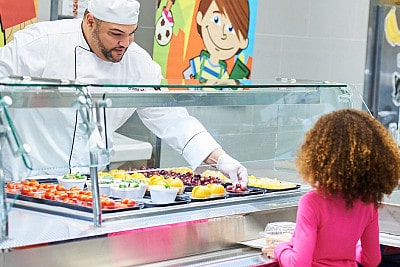 Lunches served in public schools in the U.S. are overseen by the U.S. Department of Agriculture through the National School Lunch Program. (Non-profit private schools and residential childcare centers can participate, too.)
Lunches served in public schools in the U.S. are overseen by the U.S. Department of Agriculture through the National School Lunch Program. (Non-profit private schools and residential childcare centers can participate, too.)
Meals are carefully designed to meet federal nutrition standards that require schools to limit salt, fat, and sugar content, and serve more whole grains, fruits, and vegetables so kids get the right amount of key vitamins and minerals.
It might surprise parents, Alysia says, to know the chicken patties or cereal bars schools buy to serve students aren’t the same as you yourself can buy in your local grocery store. “They’re specifically made for school nutrition,” she says, with the right balance of nutrients. Every meal must include a fruit, veggies (such as beans and dark, leafy greens), a grain, a lean protein, and low-fat milk that provides calcium and vitamin D.
In fact, a school lunch provides one-third of the nutrition needs of most children for the day.
Q: Are the ingredients in school lunches as high quality as I’d pack myself?
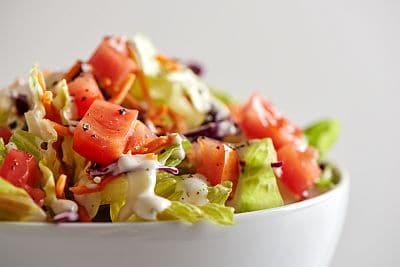 Schools get their ingredients from a variety of sources, including top manufacturers and American farmers. Many schools try to use seasonal ingredients whenever possible.
Schools get their ingredients from a variety of sources, including top manufacturers and American farmers. Many schools try to use seasonal ingredients whenever possible.
For example, in the early fall, a school might feature local tomatoes served sliced and fresh and on pizza. In later fall, schools might serve more apple- or squash-inspired recipes.
School chefs or cooks often use herbs and spices to enhance the foods, too. “It’s about making the food flavorful while staying within the guidelines,” Alysia says.
Recipes feature a variety of food preparations. For example, instead of plain, steamed, broccoli, a school might serve it roasted. Some schools use ingredients to make variations of meals their student population is used to eating at home.
“It’s about getting to know your families,” Alysia says, “showing them that healthy food does taste good, and getting students excited about school lunch.”
Q: I’ve seen school lunch in the news recently. What’s changing and is the news good for kids?
Guidelines around school lunches are reviewed every five years. The USDA has most recently proposed additional changes that would make school meals even healthier for kids. These changes include:
- Lowering sodium gradually, and by 30% overall, by the fall of 2029;
- Lowering the amount of weekly added sugars to 10% of total calories by the fall of 2027; and
- Doing away with access to flavored milk for younger students by 2025.
Guidelines also put a greater emphasis on whole grains and encourage schools to use more locally grown food.
“That helps students understand where their food is coming from,” Alysia says. The USDA expects to release a final rule in time for schools to plan for the 2024-2025 school year. Whatever the final details are, parents should know that it’s all about making sure their children are getting the best fuel for their school day.
Q: I see things on the school lunch menu that don’t look healthy (e.g., chicken nuggets.) What’s that about?
 The chicken nuggets served on school lunch trays are not at all the same as those you see at your local fast-food chain, Alysia says: “They’re lower in both fat and in sodium.”
The chicken nuggets served on school lunch trays are not at all the same as those you see at your local fast-food chain, Alysia says: “They’re lower in both fat and in sodium.”
School lunch chicken nuggets are baked, they use whole grain breading, and they have less salt.
Pizzas served at school are cooked with whole-wheat crust, no-added-sodium tomato sauce, and lower fat cheese.
Canned fruits either come packed in extra light syrup or they’re not sweetened at all.
Q: Do school lunch regulations and rules mean that all school lunches are the same across the country?
School districts across the country work within a framework, but they still find ways to customize and cater to their students’ tastes and preferences. Some schools do this by holding taste tests in the cafeteria and asking students for feedback. Others work with teachers on special projects like featuring modified family recipes in school cafeterias.
“It’s good to get students’ involvement as much as possible,” Alysia says. “And it’s really rewarding for them to see something inspired from their own home served in their schools.”
Q: My child is a picky eater. Are there choices on their school lunch program that they’ll enjoy?
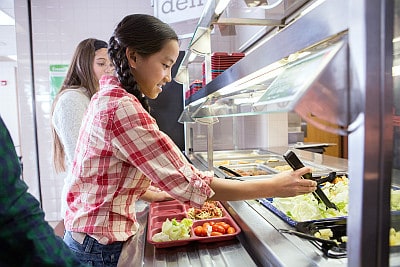 Schools strive to have a variety of options on a given day—a hot entrée, a salad, a sandwich. So, if a child doesn’t like one part of the meal, they won’t go hungry.
Schools strive to have a variety of options on a given day—a hot entrée, a salad, a sandwich. So, if a child doesn’t like one part of the meal, they won’t go hungry.
Menus also rotate, meaning if children do encounter a food they have a particular aversion to, they likely won’t see it again for several weeks.
Often, a child has to taste a new food multiple times before they like it, so this exposure to a variety of foods on a schedule could actually benefit picky eaters by helping to develop their palates.
Get more ideas for picky eaters.
Q: But what if my child has food allergies?
Researchers estimate that around one in 13 children in the U.S. have a food allergy, so school cafeterias are well prepared.
Protocols vary by district. But, in general, many school kitchens have a worker who is allergen certified (trained to handle the top allergens and on cross-contact) and they can make accommodations for students with documented allergies.
Districts can provide lactose-free or dairy-free milk and use gluten-free products as substitutes for wheat-based items if a child has been diagnosed with an issue. Special cutting boards can be used for children with celiac. Some districts decide to go nut-free.
“I’m a mom of a kid with allergies, so I get that there’s always this hesitation,” says Alysia. “But staff members are trained on how to handle allergies and how to provide a safe meal to the students.”
Q: Okay, school lunches sound good, but wouldn’t it be cheaper just to pack a lunch for my child myself?
 Not necessarily. Purchasing a school lunch can be a big money saver over the course of a year.
Not necessarily. Purchasing a school lunch can be a big money saver over the course of a year.
One national analysis put the cost of a home-packed lunch at more than $1 over that of a school-provided one.
Having your child eat lunch at school also saves time—the minutes you spend agonizing over what to send each day and then the time spent loading their lunchbox.
Ten minutes a day packing a school lunch translates into 30 hours every school year. Even if you do decide that packing is a good option for your family, it’s good to know that school lunch is a nutritious option.
Q: What if my child and their friends are consistently unhappy with some of the food on the school menu?
Speak up. No school meal program is perfect. You may even periodically see unappealing pictures of your school’s lunches posted on social media. If that’s the case, know you’re not always getting the full picture.
Still, it is a challenge to feed students on a limited budget, and sometimes change is needed. School lunch staff genuinely want to hear from parents and students and like when they’re engaged.
As you give input, remember that, while guidelines do exist, there’s also flexibility in the system to create meals that match well with the student population at your school.
Some schools have a wellness committee, or a family advisory committee made up of parents that meet and make recommendations. If your school doesn’t have one, start one. “If you don’t like what’s on the menu, come talk to the staff,” Alysia adds.
What’s a Parent to Do?
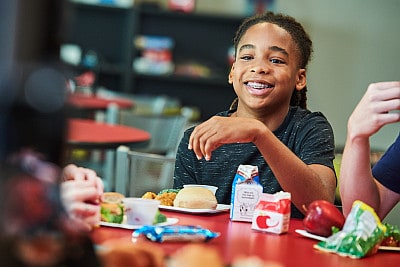 What can I do to make sure my child is eating a healthy meal at school?
What can I do to make sure my child is eating a healthy meal at school?
Start by supporting and talking about the positives of school meals, even if your child isn’t eating them every day, or even at all. “That helps to break down the stigma that school lunch isn’t healthy,” Alysia says.
Aside from that, you can:
Peruse the menu. Sit down with your child at the start of each week and talk about what’s on the school lunch menu. Maybe there’s a food your child gets excited about.
Sample new foods at home. When you normalize trying new foods at home, it can make it easier for your child when they encounter a new food on their school lunch tray.
Talk up taste tests. If your school cafeteria samples new recipes or techniques as a way to refine its offerings, encourage your child to participate.
Above all, parents should get involved and stay engaged to help ensure school lunches are a success. “Getting 100% satisfaction all the time is not going to happen, but most parents would be surprised at how focused their school dining team is on student satisfaction” says Alysia. “The more parents get involved, the better experience for the students. It really helps to have positive and supportive moms, dads, and caregivers engaged with us.”
Alysia Spooner-Gomez is a Registered Dietitian and part of Aramark’s Nutrition Network—a community of dietitians within Aramark Student Nutrition. The Nutrition Network connects and engages Aramark Student Nutrition RDNs and other nutrition experts in ways that benefit school students, parents and caregivers, and their district’s health and wellbeing initiatives.
Note: Since everyone’s health history and nutritional needs are so different, please make sure that you talk with your doctor and a registered dietitian to get advice about the diet and exercise plan that‘s right for you.

